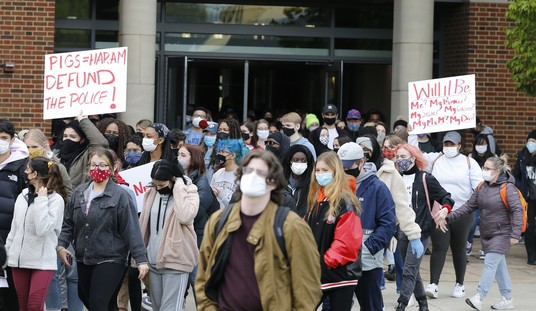=========
=========
Promoted from the diaries by streiff. Promotion does not imply endorsement.
=========
=========

Re-posted from RealClearEducation Nov. 22, 2019 (sister site to Real Clear Politics)
Released late last month amid Washington’s impeachment frenzy was a noteworthy piece of news dubbed the “Nation’s Report Card.”
Unfortunately, the alarming scores of fourth and eighth-grade students in math and reading barely made a ripple in the clogged media environment. But being under-reported does not diminish the information’s momentous consequences: A national future saddled with severe economic and social division — foundational elements traditionally linked with the potential for political upheaval.
The Nation’s Report Card, a congressionally mandated project within the Department of Education, is issued by the National Assessment of Educational Progress. According to its website, NAEP “is the only assessment that measures what U.S. students know and can do in various subjects across the nation, states, and in some urban districts… NAEP has provided important information about how students are performing academically since 1969.”
The U.S. government is not sugarcoating the sub-standard report scores, as evidenced by the Oct. 30 release day opening statement of U.S. Education Secretary Betsy DeVos:
“Every American family needs to open The Nation’s Report Card this year and think about what it means for their child and for our country’s future. The results are, frankly, devastating.”
What were the scores that earned a “D” for “devastating”? Here are a few highlights (or rather lowlights): Only 34% of Grade 8 students are at or above NAEP proficiency in math and reading. Conversely, that percentage is “D” for “disturbing” when two out of every three young American teenagers are not proficient in the two benchmark subjects.
Even more disturbing is a downward trend in math proficiency as students grow. The report card displays Grade 12 math proficiency at only 25%. (Note: Grade 12 scores are from 2015 with a report side note indicating that the 2019 Grade 12 scores in math and reading are “upcoming.” But in the unlikely event that the 2019 Grade 12 math scores were to jump nine percentage points to equal the 2019 Grade 8 score, that would still be improving only from an “F” to a “D.”)
Now couple those math percentages with reading scores indicating 63% of Grade 12 students (2015 results) and 66% of eighth-graders are also scoring below proficiency.
The only “good” grade shown in the report card is that 46% of Grade 8 students in 2018 performed at or above proficiency in “technology and engineering literacy.” (But that still means 54% — or more than half — are not. And no comparison to Grade 12 scores was displayed.)
Surely the only people celebrating these “devastating” scores are Chinese leaders currently pursuing global domination in technology, defense, and economic growth.
Therefore the “D” for “dismal” National Report Card could be interpreted as a national security issue when our education system is failing to prepare the great majority of American students for global-level competition. (More on this later.)
Equally important, in an increasingly high-tech-dominated, over-all competitive U.S. market economy (which values and rewards skilled labor of any kind) is the question: Where are the majority of these “non-proficient” students — the future U.S. workforce — going to find good-paying jobs?
Sadly, the answer is nowhere. Given that low reading scores often translate into poor communication and language skills — while low math scores point to a potential deficiency in highly sought-after STEM skills — the job market is a cruel reality check.
Operationalizing that reality check while illustrating and echoing the impact of the National Report Card is this Sept. 26 Washington Post headline: “Income inequality in America is the highest it’s been since Census Bureau started tracking it, data shows.”
The piece reports: “The persistent rise in inequality has become a central topic in the 2020 presidential race, with candidates like Bernie Sanders and Elizabeth Warren calling for a wealth tax.”
And to that, let’s add a general drift by younger voters toward what is traditionally perceived as more “socialist” government policies such as free health care, guaranteed income, and free college tuition. Ironically, on Oct. 28, two days before the release of the report card, there was an Axios headline reflecting a recent poll: “70% of millennials say they’d vote for a socialist.”
Is this the future of America? Class warfare, extreme tax-the-rich policies, a huge gap between rich and poor, and over-reliance on the government because a majority of citizens can’t compete in the marketplace earning at least middle-income wages? That question should be asked in the next Democratic debate.
Even though the report card was a one-day story, two important facts must permanently resonate. First, the headline from a U.S. Census Bureau report dated May 21, 2019: “U.S. School Spending Per Pupil Increased for Fifth Consecutive Year.” The accompanying press release began as follows:
“The amount spent per pupil for public elementary and secondary education (prekindergarten through 12th grade) for all 50 states and the District of Columbia increased by 3.7% to $12,201 per pupil during the 2017 fiscal year, compared to $11,763 per pupil in 2016, according to new tables released today by the U.S. Census Bureau.”
Therefore, low student performance can’t be blamed on funding cuts.
Second, and this speaks to the potential national security problem alluded to earlier, is a 2017 Pew Research Center report headline: “U.S. students’ academic achievement still lags that of their peers in many other countries.”
Finally, what our nation faces is a failing education system morphing into economic, political, and national security problems that appear to be unsolvable.
Let’s not kid ourselves, the report card called “devastating” by Betsy DeVos is a sign of a national grade “D” for “decline,” which elected leaders of either party are loath to admit or confront and powerless to correct.
Recognizing and coming to grips with that truth should be the leading 2020 hot button issue.













Join the conversation as a VIP Member